 |
||
|
||
| ||
Here comes an autumn of 2000. The last autumn was quite vivid: GPU NVIDIA GeForce256 and S3 Savage2000 were announced. This autumn is more calm: NVIDIA seems to put off a release of its new GPU called NV20, 3dfx tries to put things right after it has released its new super accelerator Voodoo5 6000. The ATI Technologies company has stepped aside for a while got tired after the competition with NVIDIA and after a release of its RADEON chip. Though it promises to announce a new RADEON with SDR-memory as a competitor of GPU NVIDIA GeForce2 MX. And what about Matrox? A year has already passed since Matrox released its new dual-head videocard, Matrox G400 and Matrox G400 MAX. The delight of EMBM has come down and now everybody can feel how high is the price for G400 MAX. And for the ordinary G400 the price has fallen not so long ago. Undoubtedly, this is beyond any competition as a 2D board, but it's still far not the best as for 3D. Moreover, the manufacturer delayed a release of a good ICD OpenGL driver. Recently Matrox produced a mini-driver TurboGL, optimized for Quake3. And at last, Matrox has succeeded in production of ICD OpenGL driver for its G400 based boards. We should point out that G400-cards were not only for games, but they also of semi-professional and professional type for a work with 2D-graphics. G400 based videocards are intended mostly for big and huge displays for complex 2D-graphics and an accurate design (where in the first place is thin lines drawing and shot change speed). The satisfactory 3D characteristics allow to play 3D-games. Extra possibilities of DualHead G400 based cards provide the same design works with 2D-graphics (in case you need 2 displays). Besides, there you can display an image not only on the display's screen but also on the TV screen. Well, we may say that Matrox G400 based boards have its own circle of users, taking into account its inexpensive price. The only exception is Matrox G400 MAX based boards, which cost too much even with the increased frequency of RAMDAC up to 360 MHz. The Matrox company seems to be slow with something really new - now it's producing a modification of G400 implemented according to 0.18 micron technology, it's called G450. Below you can read Matrox G450 characteristics:
You can see that all the difference between G450 and G400 are the 0.18 micron technology. It must raise the graphics core clock frequency and decrease the temperature of the chip. However, the working frequency of the chip remained the same - 126 MHz. It puzzles. G450 card uses DDR SDRAM, and the size of the local memory bus is 64 bits and, in result, its bandwidth remained on the same level (64*2 bit*162 MHz = 2.5 GBytes/s). But it's not so boring, there are still some more differences between G450 and G400. First of all, it's concerned with RAMDAC, the special chips, converting a digital data stream into an analog signal, witch is transferred to the CRT display. Similar to Matrox G400 DualHead, the G450 card has 2 RAMDACs. They are both integrated in one chip with a graphics core (unlike G400, where the secondary RAMDAC with quite weak characteristics is carried out onto another chip together with two CRTC modules - Cathode Ray Tube Controller). The primary RAMDAC frequency of G450 is 360 MHz, what corresponds to Matrox G400 MAX level. The secondary RAMDAC frequency is equal to 230 MHz. This must allow to get a high quality image on the second display. The both CRTC modules (which allow the DualHead technology) of G450 are also integrated in one chip with a graphics core. So, an integration degree has increased, it means that production costs have come down. A different feature of G450 is the support of DVI (Digital Video Interface) - image output on an LCD-display with digital interface. A control element is also integrated in one chip together with G450 core. Undoubtedly, the DualHead technology is a main advantage of G450 chip and the relative cards. Now I want you to pay attention to the main features. After connection 2 signal receivers to the videocard, the user may see that the card identifies DualHead activation: 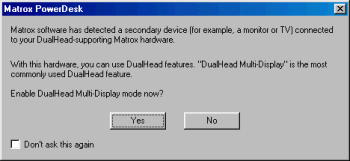 Further all display settings concerned 2D-graphics are divided between 2 receivers (in this case - between the displays): 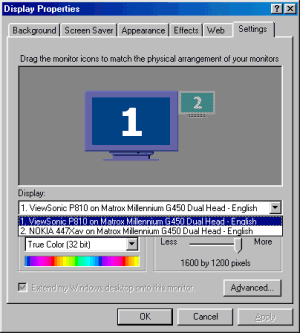 The DualHead of G450 doesn't much differ from that of G400. In the first case, there is more universal support of receivers, the list of which contains displays with digital interface. So, with DualHead we can get the following:
We know that NVIDIA offers a similar thing in the GeForce2 MX based videocards - it uses the TwinView technology. At this moment we can't carry out a comparison test of TwinView and DualHead. But as soon as it's possible, we'll do it. Now I'll try to summarize the material from the Internet. A main drawback of TwinView is a big number of chips, which must increase its cost. Later we'll compare the prices and you'll see whether it's right or not. Since 3D of G450 doesn't differ from that of G400, we won't consider these features again. One more thing to point out is Vibrant Color Quality2 technology that allows to get high quality pictures, and first of all in 16-bit color mode. Well, now we have got Millennium G450. In principle, there are several different cards based on G450, but all they differ in a videomemory size (16 or 32 MBytes), a package type (OEM or Retail) and a price. Let's take a close look at this card. The boardThe card has the AGP2x/4x interface, 32 MBytes 6 ns DDR SDRAM located in 4 chips on the right side of the PCB. 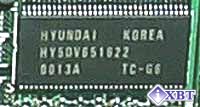 The memory chips are produced by Hyundai; the working frequency is 166 MHz. The working frequency of the memory is 162 MHz. Sometimes, you can meet the result value of DDR clock frequency, that is 324 MHz; it looks rather impressive, though the real value is 162 MHz. The graphics core frequency is 126 MHz. As we mentioned above, it's quite strange: with the 0.18 micron technology the working frequency of the chip might rise. But it seems that the high integration doesn't allow to increase the clock frequency. Or maybe Matrox doesn't just want to bother about it. Thanks to 0.18 technology the chip hardly warms up, and that's why it has only fin-radiator without an extra fan. 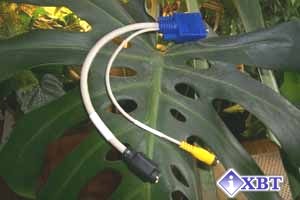 The board is a traditional dark-green color. The PCB has 2 jacks for VGA-displays. The complete set includes an adapter for TV. The delivery package is Retail. The box is traditionally blue color, though its design is quite unusual: 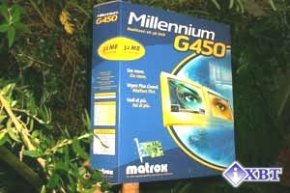 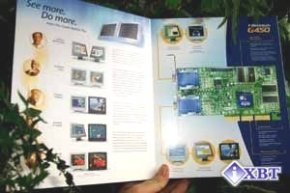 There you can find an installation manual, a CD with drivers and TV-out adapter. OverclockingUnfortunately, this sample doesn't want to maintain irregular frequencies. Despite the fact that the chips fairly warms up, the graphics core fails to sustain even 130 MHz. Installation and driversNow let's move to a practical part of our review. The testbed is:
The drivers used are from Matrox 6.10. The videocard is supplied together with drivers of both 6.04 version and 6.10. They are uniform drivers of PowerDesk series, which support G200, G400 and G450 based cards. Test resultsLet's start with 2D-graphics. As it was expected, the image quality is excellent. At least, neither ViewSonic P810 nor ViewSonic P817 show any image degradations as compared with G400 MAX. But as for the speed, it's not very good from WinBench'99 "point of view":
WinBench'99 results
As you can see, Matrox Millennium G450 fails completely in this test. Even the cheaper G400 based card shows better. Of cause, it's not the crucial criterion when choosing the card, as even this speed is more than enough. However, the fact that the Matrox G450 falls behind the NVIDIA GeForce2 MX in the 2D speed test makes an unpleasant impression. The speed results of Matrox Millennium G450 in 3D-graphics will be considered on the base of 2 games:
This is fully enough to show the card performance when working through 2 main API. The diagrams below demonstrate speed results of 2 more videocards: Matrox Millennium G400 DualHead and reference card based on GeForce2 MX from NVIDIA. 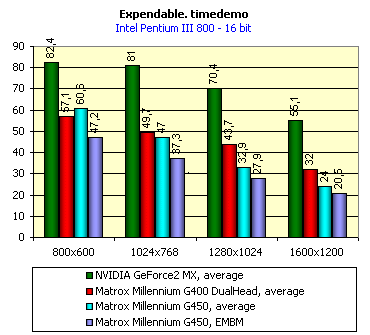 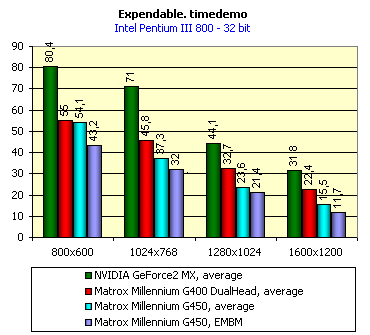 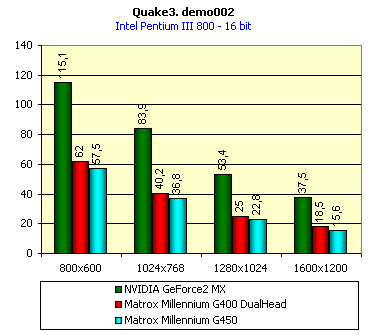 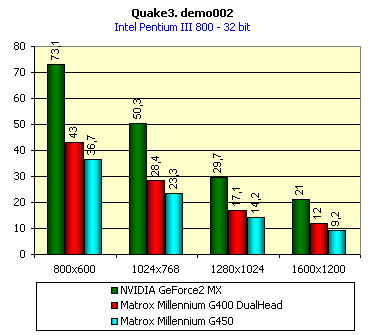 It's sad. It lags behind not only NVIDIA GeForce2 MX based card, but even its elder fellow that works on the same frequency! The only parameter that is the same for the both cards is the performance decrease when EMBM support is switched on. As for DVD playback, Matrox Millennium G450 succeeded here, fortunately. The board includes a Matrox DVD player, which is easy to install and operate:  While DVD playback, the CPU load isn't more than 22-24%. ConclusionOn the one hand, G450 based cards can completely satisfy those, who works with powerful 2D-packets. On the other hand, Matrox G400 DualHead provides the user with practically the same. Besides, 3D cards based on G400 have higher performance characteristics. Moreover, there are cheaper NVIDIA GeForce2 MX based cards with TwinView technology included, that gives a possibility both to work perfectly in 2D, and to play 3D-games. EMBM of Matrox G450 doesn't help there at all. The NVIDIA GeForce2 MX based cards with TwinView support cost $160-170, and G450 based cards with 32 MBytes videomemory cost $145-170. The only cards that can compete with the leader are low-cost 16- MBytes Matrox G450 based cards at the price of $90-130. Highlights:
Lowlights:
Write a comment below. No registration needed!
|
Platform · Video · Multimedia · Mobile · Other || About us & Privacy policy · Twitter · Facebook Copyright © Byrds Research & Publishing, Ltd., 1997–2011. All rights reserved. | |||||||||||||||||||||||||||||||||||||||||||||||||||